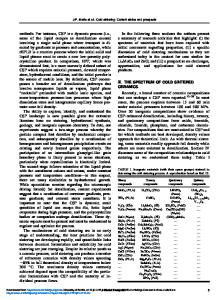Current Status and Future Prospects of Warm Spray Technology
- PDF / 3,342,477 Bytes
- 24 Pages / 593.972 x 792 pts Page_size
- 10 Downloads / 609 Views
eiji Kuroda, Makoto Watanabe, KeeHyun Kim, and Hiroshi Katanoda (Submitted January 4, 2011; in revised form March 4, 2011) A modification of high-velocity oxy-fuel (HVOF) thermal spray process named as warm spray (WS) has been developed. By injecting room temperature inert gas into the combustion gas jet of HVOF, the temperature of the propellant gas can be controlled in a range approximately from 2300 to 1000 K so that many powder materials can be deposited in thermally softened state at high impact velocity. In this review, the characteristics of WS process were analyzed by using gas dynamic simulation of the flow field and heating/acceleration of powder particles in comparison with HVOF, cold spray (CS), and high-velocity air-fuel (HVAF) spray. Transmission electron microscopy of WS and CS titanium splats revealed marked differences in the microstructures stemming from the different impact temperatures. Mechanical properties of several metallic coatings formed under different WS and CS conditions were compared. Characteristics of WC-Co coatings made by WS were demonstrated for wear resistant applications.
Keywords
cermet coatings, cold gas dynamic spraying, gas dynamics simulation, HVOF process, titanium, oxidation during spraying, TEM, wear and corrosion
1. Introduction Since the first papers on warm spraying (WS) were published in 2006 (Ref 1, 2), significant efforts have been made to understand its process fundamentals (Ref 3-14) as well as to explore potential advantages of coatings made by the process for industrial applications (Ref 15-20). Various thermal spray processes are classified schematically in terms of particlesÕ temperature and velocity on a so-called process map (Ref 21-23) as shown in Fig. 1. In classical processes such as wire arc and flame spray, powder particles are almost completely melted and the impacting velocity onto the substrate is usually below 200 m/s. Plasma spray expanded the capability of thermal spray to a significantly high temperature range to include refractory materials such as oxides and high melting points metals into the sprayable feedstock materials. The particlesÕ velocity increased remarkably by the advent of highvelocity oxy-fuel (HVOF) process in the 1980s and the process includes a certain proportion of unmolten particles, of which amount depends on both the feedstock material and the process conditions. In 1990s, cold spray (CS) was invented, by which completely solid particles are Seiji Kuroda, Makoto Watanabe, and KeeHyun Kim, National Institute for Material Science, Sengen 1-2-1, Tsukuba, Ibaraki 305-0047, Japan; and Hiroshi Katanoda, Kagoshima University, Korimoto 1-21-24, Kagoshima 890-0065, Japan. Contact e-mail: [email protected].
Journal of Thermal Spray Technology
projected onto the substrate to form coatings (Ref 24-26). The minimum velocity required to induce bonding of particles by adiabatic shear instability is defined as critical velocity, which depends on each metalÕs physical properties (Ref 27). The warm spray process is based on highvelo
Data Loading...











